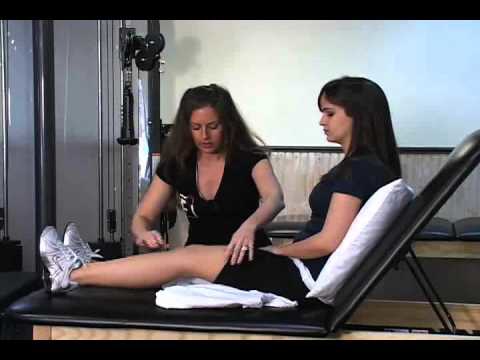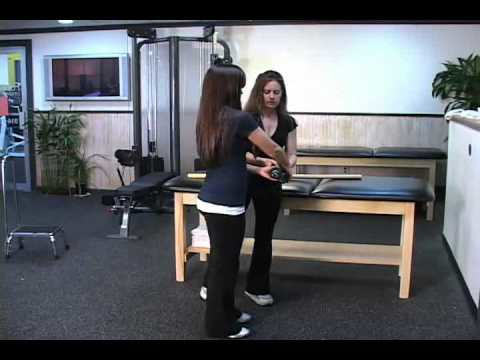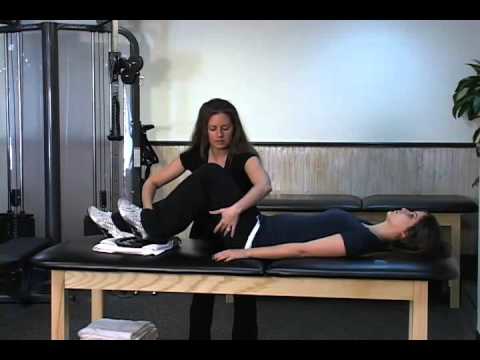Hamstring Strain
By Terry Zeigler, EdD, ATC Last Updated on August 12, 2024 by The SportsMD Editors
Last Updated on August 12, 2024 by The SportsMD Editors
What is a hamstring strain?
The hamstring muscle group is the most frequently strained group of muscles in the body. The hamstring muscle group is actually made up of three muscles that cross both the hip and knee joints. These muscles are located on the back of the hip and thigh and include the biceps femoris, semitendinosus, and semimembranosus.
A hamstring strain is considered an acute injury. An acute injury is one in which the athlete can trace the mechanism of injury back to a specific point. Usually, the athlete knows right when the injury occurred and so often do all of those watching because the athlete will pull up during a sprint and grab the back of his/her leg.
Who gets a hamstring strain?
A hamstring strain can be seen in athletes competing in many sports that require quick explosive movements including track and field, soccer, baseball, softball, basketball, tae kwon do, and football. Any athlete in a sport that requires explosive movements and quick changes in direction can be at risk for a hamstring strain.
Hamstring strain symptoms
The classifications of a hamstring strain are dependent on the amount of tissue damaged. Hamstring muscle strains are classified as first, second, and third degree.
A first degree hamstring strains is classified as mild and may be characterized by “tightness” in the muscle. A fist degree strain would result from stretching or small tears of the muscle fibers within the muscle. The athlete would have pain on stretching the muscle and have some weakness when the hamstring muscle group is manually tested. An athlete may be able to have a normal gait, but would have pain on any increase in the intensity or speed of movement (moving from a light jog to a sprint).
A second degree or grade 2 hamstring strain is classified as a moderate injury. Because there is a greater amount of tissue damage, a second degree strain will have significant impact on the functional ability of the leg. An athlete may have localized discoloration, muscle spasm, point tenderness over the injury site, swelling, a painful gait, limited range of motion, and weakness in the muscle. The discoloration may initially show at the site of the tear, but may move distally due to the force of gravity.
Third degree hamstring tears are full ruptures of the muscle either within the muscle belly or at the musculotendinous junction (where the muscle and tendon connect). A third degree tear is a significant injury with symptoms that may include a noticeable gap or deformity within the muscle, point tenderness over the injury site, muscle spasm, extensive swelling, extensive discoloration (may have bruising all the way down the back of the leg), a painful gait, significant decrease in range of motion of both the hip and knee, and significant weakness when the muscle is manually tested.
Because a third degree tear will have an obvious deformity within the muscle and may impact the function of the muscle, these types of injuries need to be treated by an orthopedic surgeon who may need to surgically repair the muscle.
How is a hamstring strain diagnosed?
A sports medicine professional can diagnose a hamstring strain given a thorough medical history and comprehensive physical assessment. If a third degree hamstring strain is suspected, an MRI can be ordered to look specifically at the muscle tissue.
What causes a hamstring strain?
The quadriceps muscle group is a group of four muscles located on the front of thigh. The quadriceps muscle group and hamstring muscle group work in conjunction to move the hip and the knee. The fact that both muscle groups cross both the hip and knee joints is important for understanding why this set of muscles are so often injured.
Tight hamstring muscles are one cause of a hamstring strain. If the hamstring muscle group is tight, the muscle fibers can tear as the lower leg explosively swings through in extension.
Another cause of a hamstring strain is when there is a muscle strength imbalance between the quadriceps and hamstring muscle groups. Athletes tend to focus on the development of the strength and power of their quadriceps muscle group, but may not give the hamstring muscle group the same amount of attention in the weight room.
If the quadriceps muscle group is significantly stronger than the hamstring muscle group, the hamstring muscles can be injured during the powerful swing through motion of the knee extension caused by the quadriceps. One of the roles of the hamstring muscles is to eccentrically (lengthening contraction) decelerate the swing-through phase of the lower leg during a sprint.
If the strength of the hamstring muscle group is weaker than the quadriceps muscle group, then an injury may occur due to the force of the quadriceps overpowering the hamstring muscle group.
Fatigue has also been associated with hamstring strains (Greig, M. & Sielger, J., April, 2009). According to their research, 47% of hamstring strains studied in English professional soccer athletes occurred in the final 15 minutes of each half. Their study specifically looked at soccer-specific fatigue and eccentric knee muscles (hamstrings). Their results indicated that eccentric hamstring strength did decrease over time and may be a contributing factor to hamstring injury.
What can I do to prevent a hamstring strain?
Because hamstring strains are primarily caused by tight hamstrings and muscle strength imbalances, the focus of a prevention program needs to be on a flexibility and strength program.
Flexibility of the hamstring muscle group can be improved through consistent daily stretching exercises specifically geared for the hamstring muscle group. It is well known that muscles that are consistently and properly stretched will increase their tissue flexibility. However, it is also well known that muscles that are not stretched will get tighter and tighter over time.
Hamstring stretches can be performed in a variety of positions. The key to a successful stretch is to elongate the muscle to the point of discomfort, then back off slightly, and hold the position for 30 seconds. This stretch is then repeated two more times for a total of three times for each leg.
Effective hamstring stretches include:
• Supine hamstring stretch (hip flexed, knee extended)
• Figure four on the floor
• Sitting both legs extended
• Standing stretch (let on table)
Strengthening of the hamstring muscle group is another way to prevent hamstring injury. Care must be focused on ensuring that the hamstring muscle group gets the same attention in the weight room as the quadriceps muscle group. Balancing out the number of exercises for each muscle group is one way to keep the muscle groups in balance.
Focused hamstring strengthening exercises include a hamstring curl with the athlete either prone, standing, or sitting depending upon the machine. The key for this exercise is for the hip to remain in a position of slight flexion while the knee moves from full extension to full flexion.
The amount of weight lifted is appropriate if the athlete can move the weight through the full range of motion ending with the feet in a position by the buttocks. If the athlete can only move the weight partially through the range of motion of the knee, then the amount of weight needs to be decreased until full range of motion is achieved.
There are two types of strength exercises that need to be incorporated to reduce the risk of a hamstring strain. Traditionally, concentric contractions (type of contraction in which the muscle shortens during the contraction) were only performed. This type of exercise is good for building strength and power in a muscle. However, recent research now indicates that athletes should also focus on eccentric (type of contraction in which the muscle lengthens during the contraction) hamstring exercises.
The conclusions made in the study on professional soccer athletes by Greig, M. & Siegler, J (April, 2009) indicated that incorporating eccentric hamstring exercises into a resistance program after soccer-specific conditioning (when the muscle is fatigued) may reduce the incidence of hamstring strain injuries.
Because eccentric-type exercises may cause injury if not done properly, these types of exercises should be done carefully and with supervision.
Hamstring strain treatment
Initial Treatment (1-3 days)
The initial hamstring strain treatment will depend on the severity of the injury. But in general, the athlete should be pulled from the activity and have an ice pack immediately applied to the area for twenty minutes. After the twenty minutes, the hamstring muscle should be securely wrapped with an ace bandage for support.
If a second or third degree strain is suspected, the athlete should be fitted for crutches, provided crutch-walking instructions, and referred for further medical evaluation.
The athlete should continue with a cycle of twenty minutes of ice followed by a compression wrap for the first 48 – 72 hours. The individual should also limit their activity and rest the leg as much as possible in a position of elevation (leg above the heart level). Sports injury treatment using the P.R.I.C.E. principle will help reduce the amount of swelling in the thigh.
Hamstring strain rehab (3 – 7 days)
When the swelling and pain begin to reduce, the athlete can then move into the next stage of rehabilitation with the focus on regaining range of motion, tissue mobility, and strength.
In this phase, the athlete can begin treatment with heat. The heat can either be moist heat (Jacuzzi, whirlpool) or dry heat (hot pack). The heat should be applied for 10 – 15 minutes for the purpose of increasing circulation to the tissue and increasing extensibility of the muscle fibers.
Immediately after the heat while the tissue is still warm and pliable, gentle massage can be given to the area. The purpose of the tissue massage is to keep the tissue mobile and decrease the possibility of adhesions and/or scar tissue from forming within and around the injured muscle tissue. The tissue should be massaged gently with care that pain is not induced.
Now that the tissue is warm and extensible, gentle stretching exercises can be begun. Care must be taken to stretch the muscle tissue, but not to cause pain. Overaggressive stretching can damage the new tissue being laid down and elongate the healing and rehabilitation process. Gentle stretching exercises can be performed twice a day during this phase of recovery.
Once the muscle has been adequately stretched, strengthening exercises can be performed. Because the hamstring muscle group crosses two joints, these exercises need to focus on both hip extension and knee flexion. The focus at this point is to provide mild resistance to the muscle, but to not perform any resistance exercise that causes pain or may reinjure the new tissue.
An example of a hip extension exercise is prone hip extension. The athlete lies prone on the floor and performs a straight leg hip extension while ensuring that the pelvis stays flat on the floor. This can be performed with ankle weights or with manual resistance applied at the lower leg.
To further work the hamstring muscle group, the athlete remains in the same position on the floor keeping the pelvis and thigh flat on the floor and then flexes the knee. Both of these exercises can be performed with light resistance for three sets of ten repetitions.
Hamstring strain rehab (Week 2 – Week 3)
As the muscle heals, the athlete will be able to stretch farther without discomfort and will notice that walking is more comfortable. If full range of motion is still not achieved, the athlete needs to continue to focus on heating, tissue mobility, and stretching the tissue prior to adding more exercises. A strong muscle is irrelevant if the tissue remains tight.
Once full range of motion is achieved, the athlete can then advance to functional exercises for the hip and knee. These types of exercises also load the muscles but are done in a standing position.
Examples include:
– Wall squats
– Lunge
– Mini-squats
– Step exercises
– Step-ups/Step-downs
Proprioceptive exercises can also be added during this phase to improve balance, agility, and coordination. Proprioceptive exercises are a series of balance exercises that improve the neuromuscular feedback system damaged when the muscle was injured. These exercises progress from simple to more difficult and from a stable surface to an unstable surface.
Examples include:
– Stork stand, eyes open
– Stork stand, eyes closed
– Stork stand, eyes open, unstable surface (wobble board, foam board, balance board)
– Stork stand, eyes closed, unstable surface
The goal of the athlete is to perform the task for a minimum of 30 seconds without losing balance beginning with the first level. Once the athlete has achieved this goal, the athlete can progress to the next level.
The last component in this phase of rehabilitation is the development of explosive power in the muscle. Once full strength has been regained (strength of the injured leg is equal to the uninjured leg), the athlete can progress to exercises that develop power in the muscle. There is probably no other muscle in which developing power is so important to the functioning of the muscle.
Power is the “speed” component of the exercise. Any “strength” exercise can be converted to a “power” exercise if the athlete performs the exercise “as fast” as they can.
Recovery – Getting back to Sport
]The final component in any rehabilitation program is the addition of sport specific exercises. These are exercises specifically designed to put the athlete through the skills and demands of his/her sport in a progressive fashion so as to ensure that the muscle has completed healed and that the athlete has the confidence necessary to return to sport.
The athlete’s sport is analyzed for a breakdown of fundamental skills. The athlete is then asked to perform these skills beginning at 50% intensity. As the athlete continues through the list of basic skills, the intensity is gradually increased incrementally over time until the athlete performs the skills full out. Depending on the classification of the injury, this phase may take anywhere from several days to several weeks.
Hamstring Exercises
When Can I Return to Play?
Once the athlete has full range of motion of the hip and knee, full strength equal or greater than the uninjured leg, full power equal or greater than the uninjured leg, and can perform all of the fundamental skills of his/her sport pain free, the athlete is ready to return to sport.
Can Telemedicine Help?
Telemedicine is gaining popularity because it can help bring you and the doctor together quicker and more efficiently. It is particularly well suited for sports injuries and facilitating the diagnosis of the severity of the injury and a treatment plan. Learn more via SportsMD’s 24/7 Telemedicine Service.
References
- Anderson, M., Hall, S., & Martin. M. (2009). Foundations of Athletic Training: Prevention, Assessment and Management. (4th Ed.). Lippincott Williams and Wilkins: Philadelphia, PA.
- Gallaspy, J. & May, J.D. (1996). Signs and Symptoms of Athletic Injuries. Mosby: St. Louis, MO.
- Greig, M. & Siegler, J. (April, 2009). Soccer-specific fatigue and eccentric hamstrings muscle strength. Journal of Athletic Training 44(2), 180-184.
- Houglum, P. (2005). Therapeutic Exercise for Musculoskeletal Injuries. (2nd Ed.). Human Kinetics: Champaign, IL.
- Hutson, M.A. (1996). Recognition and Management: Sports Injuries. (2nd Ed.). Oxford: New York, NY.
Disclaimer: SportsMD Media Inc. does NOT offer medical advice. The content on this website is for informational purposes only. Do not rely or act upon information from www.sportsmd.com without seeking professional medical advice. Consultations on SportsMD.com are not a substitute to physical consultation with a doctor or hospital services. The service should not to be used for medical emergencies. Do not delay seeing a doctor if you think you have a medical problem. In case of a medical emergency, call 911.










